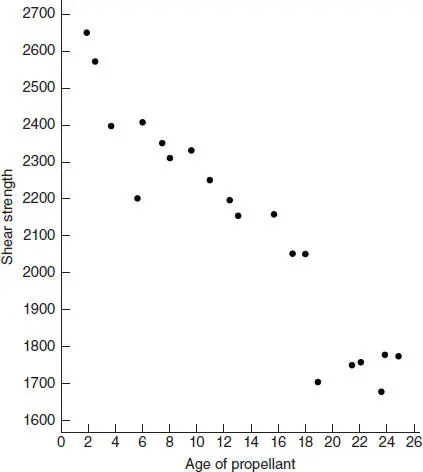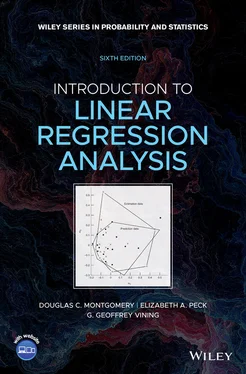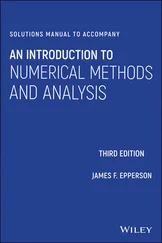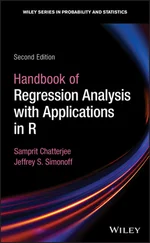1 ...8 9 10 12 13 14 ...28 TABLE 2.1 Data for Example 2.1
| Observation, i |
Shear Strength, yi (psi) |
Age of Propellant, xi (weeks) |
| 1 |
2158.70 |
15.50 |
| 2 |
1678.15 |
23.75 |
| 3 |
2316.00 |
8.00 |
| 4 |
2061.30 |
17.00 |
| 5 |
2207.50 |
5.50 |
| 6 |
1708.30 |
19.00 |
| 7 |
1784.70 |
24.00 |
| 8 |
2575.00 |
2.50 |
| 9 |
2357.90 |
7.50 |
| 10 |
2256.70 |
11.00 |
| 11 |
2165.20 |
13.00 |
| 12 |
2399.55 |
3.75 |
| 13 |
1779.80 |
25.00 |
| 14 |
2336.75 |
9.75 |
| 15 |
1765.30 |
22.00 |
| 16 |
2053.50 |
18.00 |
| 17 |
2414.40 |
6.00 |
| 18 |
2200.50 |
12.50 |
| 19 |
2654.20 |
2.00 |
| 20 |
1753.70 |
21.50 |

Figure 2.1 Scatter diagram of shear strength versus propellant age, Example 2.1.
To estimate the model parameters, first calculate

and

Therefore, from Eqs. (2.11)and (2.6), we find that

and

TABLE 2.2 Data, Fitted Values, and Residuals for Example 2.1
| Observed Value, yi |
Fitted Value,  |
Residual, ei |
| 2158.70 |
2051.94 |
106.76 |
| 1678.15 |
1745.42 |
−67.27 |
| 2316.00 |
2330.59 |
−14.59 |
| 2061.30 |
1996.21 |
65.09 |
| 2207.50 |
2423.48 |
−215.98 |
| 1708.30 |
1921.90 |
−213.60 |
| 1784.70 |
1736.14 |
48.56 |
| 2575.00 |
2534.94 |
40.06 |
| 2357.90 |
2349.17 |
8.73 |
| 2256.70 |
2219.13 |
37.57 |
| 2165.20 |
2144.83 |
20.37 |
| 2399.55 |
2488.50 |
−88.95 |
| 1799.80 |
1698.98 |
80.82 |
| 2336.75 |
2265.58 |
71.17 |
| 1765.30 |
1810.44 |
−45.14 |
| 2053.50 |
1959.06 |
94.44 |
| 2414.40 |
2404.90 |
9.50 |
| 2200.50 |
2163.40 |
37.10 |
| 2654.20 |
2553.52 |
100.68 |
| 1753.70 |
1829.02 |
−75.32 |
 |
 |
 |
The least-squares fit is

We may interpret the slope −37.15 as the average weekly decrease in propellant shear strength due to the age of the propellant. Since the lower limit of the x ’s is near the origin, the intercept 2627.82 represents the shear strength in a batch of propellant immediately following manufacture. Table 2.2 displays the observed values yi , the fitted values  , and the residuals.
, and the residuals.
After obtaining the least-squares fit, a number of interesting questions come to mind:
1 How well does this equation fit the data?
2 Is the model likely to be useful as a predictor?
3 Are any of the basic assumptions (such as constant variance and uncorrelated errors) violated, and if so, how serious is this?
All of these issues must be investigated before the model is finally adopted for use. As noted previously, the residuals play a key role in evaluating model adequacy. Residuals can be viewed as realizations of the model errors εi . Thus, to check the constant variance and uncorrelated errors assumption, we must ask ourselves if the residuals look like a random sample from a distribution with these properties. We return to these questions in Chapter 4, where the use of residuals in model adequacy checking is explored.
TABLE 2.3 Minitab Regression Output for Example 2.1
Regression Analysis |
The regression equation is |
Strength = 2628- 37.2 Age |
Predictor |
Coef |
StDev |
T |
P |
|
Constant |
2627.82 |
44.18 |
59.47 |
0.000 |
|
Age |
-37.154 |
2.889 |
-12.86 |
0.000 |
|
S = 96.11 |
R-Sq = 90.2% |
R-Sq(adj) = 89.6% |
|
|
Analysis of Variance |
Source |
DF |
SS |
MS |
F |
P |
Regression |
1 |
1527483 |
1527483 |
165.38 |
0.000 |
Error |
18 |
166255 |
9236 |
|
|
Total |
19 |
1693738 |
|
|
|
Computer software packages are used extensively in fitting regression models. Regression routines are found in both network and PC-based statistical software, as well as in many popular spreadsheet packages. Table 2.3 presents the output from Minitab, a widely used PC-based statistics package, for the rocket propellant data in Example 2.1. The upper portion of the table contains the fitted regression model. Notice that before rounding the regression coefficients agree with those we calculated manually. Table 2.3 also contains other information about the regression model. We return to this output and explain these quantities in subsequent sections.
Читать дальше











 , and the residuals.
, and the residuals.









